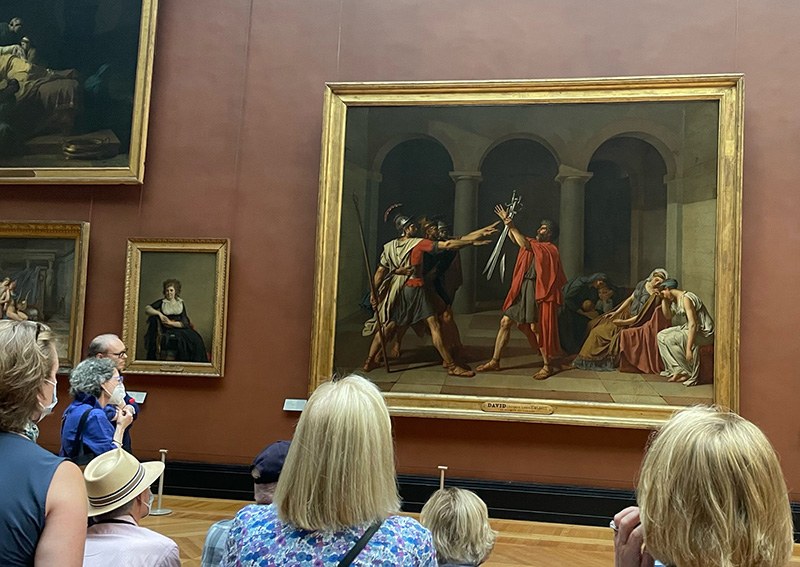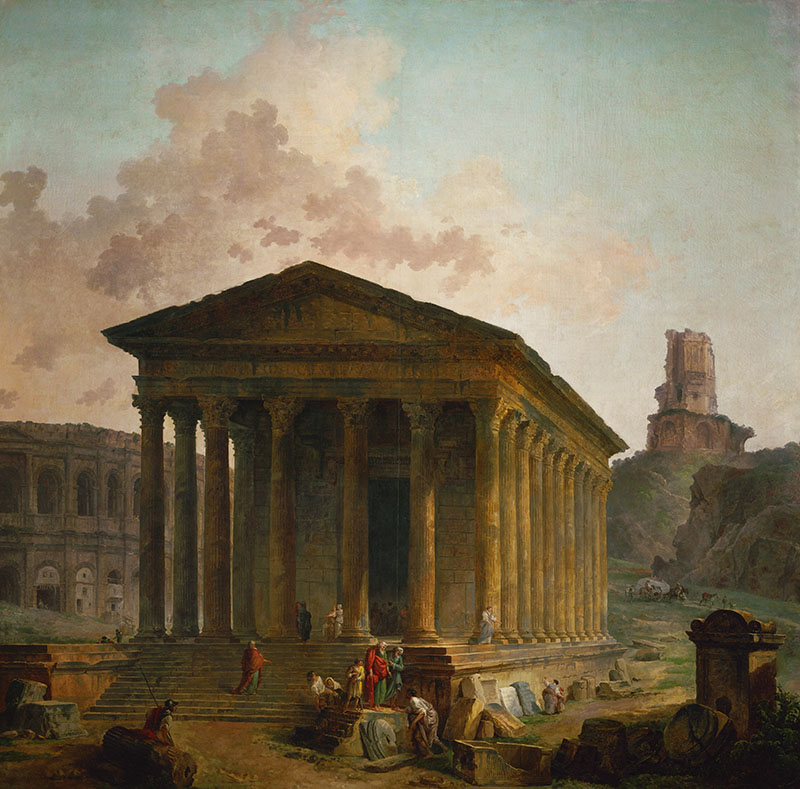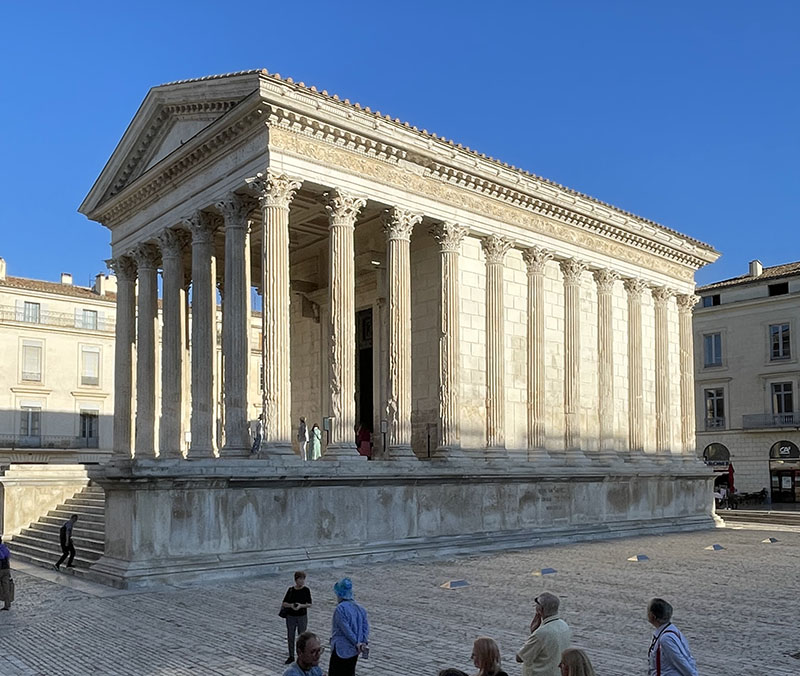Inspiring Thomas Jefferson: Art and Architecture in France
Click on images to enlarge them and view captions.
by Catherine Carlisle
To follow in Thomas Jefferson’s footsteps in Paris, as the Decorative Arts Trust did during its fall Study Trip Abroad, requires a stroll through the galleries of the Musée de Louvre. Jefferson briefly resided not far from the nearby Palais Royal before moving to the Hôtel de Langeac on the Champs Elysée. He lived in Paris from 1784–89, first as a newly appointed Minister Plenipotentiary to the court of Versailles before becoming Minister to France in 1785. Jefferson’s time in Paris was transformative for the plantation-owning, self-styled “savage of the mountains of America.”1 He immersed himself in one of the world’s greatest cities, captivated by its political and literary discussions and artistic realms. The Salons of the Louvre, in particular, proved to be a hub of inspiration: Jefferson absorbed the artistic achievements he saw on display. In particular, he gravitated to the work of Jacques-Louis David, whose widely admired historical paintings represented the undercurrents of revolutionary ideas about democratic ideals as well as civic virtue.
By the time Thomas Jefferson arrived in Paris, the Louvre had already undergone numerous transformations. Originally constructed as a fortress in the late 12th century, it was later converted by King Francois I into a palace. After Louis XIV relocated the royal residence to Versailles, the Louvre shifted from being a symbol of the monarchy to more public uses. The biannual Salons began in 1667 as the official exhibitions of the Académie des Beaux-Arts and developed into a popular and influential cultural event in the 18th and much of the 19th centuries. Every available inch of wall space in the Salon Carrée was covered by submissions from the members of the Academy; their works then became the subjects of published reviews by a burgeoning professional class of art critics.
Jefferson visited the Louvre on numerous occasions, but attending the 1787 Salon permitted him to see the work of two painters who particularly interested him: Jacques-Louis David and Hubert Robert. David’s submission memorialized the final moments of Socrates and came two years after he showed his stark and dramatic Oath of the Horatii (figure 1), considered a landmark of the Neoclassical movement and a sharp departure from the earlier whimsical Rococo favored by the aristocracy.
In The Death of Socrates (today in the collection of The Metropolitan Museum of Art), the Greek philosopher is posed rigidly upright on his prison bed, resolute that he would rather drink poisonous hemlock than renounce his beliefs to the Athenian court, while a group of his followers wail in grief around him. In a letter to John Trumbull, then studying with Benjamin West in England, Jefferson claimed, “…the best thing is the Death of Socrates by David, and a superb one it is,”2 and followed with a rather imploring note for the American painter to come to Paris to see it for himself. The painting was broadly acclaimed at the time and would be again when David re-exhibited it for the Salon of 1791. Just a few years later, in an entirely different political climate, the image of stoicism in the face of inequity resonated with the spirit of the French Revolution.
Undoubtedly, Thomas Jefferson appreciated the references to the classical world presented at the Salon of 1787. In addition to David’s canvas, he also admired the work of Hubert Robert, who submitted a series of panels depicting the architectural antiquities of Provence, a commission he received for a dining room in the Château de Fontainebleau. The series included large-scale canvases of the Pont du Gard, the Temple of Diana at Nîmes, the Arc de Triomphe and Theatre in Orange, and the Maison Carrée in Nîmes (figures 2 and 3). Jefferson had not seen Roman buildings in person before 1787 but was familiar with their composition and emphasis on balance, proportion, and symmetry through the publications of Andrea Palladio, Charles-Louis Clérisseau, and other architects. Robert’s paintings use a foreshortened perspective to cast the monuments of Provence into a grand scale, emphasizing France’s connection to antiquity and ancient wisdom. For Jefferson, the ruins of ancient Rome represented an enduring visual symbol of civic virtue, thus Classicism became the architectural language for building the first modern republic back home. Seeing Robert’s series at the Louvre, with the monuments depicted in such heightened glory, reinforced the importance of these principles in Jefferson’s mind.
In his travels to Provence, Jefferson took in as many Roman ruins as he could, but he was particularly enamored with the Maison Carrée in Nîmes and deemed it “the most perfect model of antiquity now existing” and “in the opinion of all who have seen it yeilds [sic] in beauty to no peice [sic] of architecture on earth.”3 Jefferson based his temple-front design for the Virginia State Capitol on the Maison Carrée and sought help from Clérisseau with the preparatory drawings and a model for a modern building befitting the functions of government. In return for Clérisseau’s assistance, Jefferson commissioned a Provençal craftsman named Souche to create a model of a Roman askos—a bronze pouring vessel—for the architect. The askos Jefferson so admired (figure 4) was in the collection of the scholar who had excavated the Maison Carrée, Jean François Seguier. Although Jefferson was ultimately compelled to select another gift for Clérisseau, Jefferson later had a silver version of the askos prepared by Philadelphia silversmiths Anthony Simmons and Samuel Alexander made for himself. This splendid representation of Jefferson’s fascination with antiquity remains part of the Monticello collection today as does its wooden model.
Jefferson’s attraction to the ancient world in art, architecture, and objects reflects his commitment to shape an enduring nation based on ideals of democracy, public discourse, and civic engagement. The restraint and balance in paintings of antiquity as displayed by David and Robert at the Louvre undoubtedly reinforced that the visual language of Classicism developed by the Romans would be an appropriate model for the young nation. Jefferson had indeed been “nourished by the remains of Roman grandeur,” just as he had written in 1787.
- “From Thomas Jefferson to Charles Bellini, 30 September 1785,” Founders Online, National Archives. [Original source: The Papers of Thomas Jefferson, vol. 8, 25 February–31 October 1785, ed. Julian P. Boyd. Princeton: Princeton University Press, 1953, pp. 568–570.]
- “From Thomas Jefferson to John Trumbull, 30 August 1787,” Founders Online, National Archives. [Original source: The Papers of Thomas Jefferson, vol. 12, 7 August 1787 – 31 March 1788, ed. Julian P. Boyd. Princeton: Princeton University Press, 1955, p. 69.]
- “From Thomas Jefferson to Edmund Randolph, 20 September 1785,” Founders Online, National Archives. [Original source: The Papers of Thomas Jefferson, vol. 8, 25 February–31 October 1785, ed. Julian P. Boyd. Princeton: Princeton University Press, 1953, pp. 537–539.]
Catherine Carlisle is the Manager of Educational Programs at the Decorative Arts Trust.
A print version of this article was published in The Magazine of the Decorative Arts Trust, one of our most popular member benefits. Join today!




